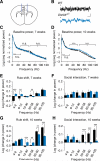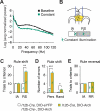Gamma rhythms link prefrontal interneuron dysfunction with cognitive inflexibility in Dlx5/6(+/-) mice
- PMID: 25754826
- PMCID: PMC4503262
- DOI: 10.1016/j.neuron.2015.02.019
Gamma rhythms link prefrontal interneuron dysfunction with cognitive inflexibility in Dlx5/6(+/-) mice
Abstract
Abnormalities in GABAergic interneurons, particularly fast-spiking interneurons (FSINs) that generate gamma (γ; ∼30-120 Hz) oscillations, are hypothesized to disrupt prefrontal cortex (PFC)-dependent cognition in schizophrenia. Although γ rhythms are abnormal in schizophrenia, it remains unclear whether they directly influence cognition. Mechanisms underlying schizophrenia's typical post-adolescent onset also remain elusive. We addressed these issues using mice heterozygous for Dlx5/6, which regulate GABAergic interneuron development. In Dlx5/6(+/-) mice, FSINs become abnormal following adolescence, coinciding with the onset of cognitive inflexibility and deficient task-evoked γ oscillations. Inhibiting PFC interneurons in control mice reproduced these deficits, whereas stimulating them at γ-frequencies restored cognitive flexibility in adult Dlx5/6(+/-) mice. These pro-cognitive effects were frequency specific and persistent. These findings elucidate a mechanism whereby abnormal FSIN development may contribute to the post-adolescent onset of schizophrenia endophenotypes. Furthermore, they demonstrate a causal, potentially therapeutic, role for PFC interneuron-driven γ oscillations in cognitive domains at the core of schizophrenia.
Copyright © 2015 Elsevier Inc. All rights reserved.
Figures







References
Publication types
MeSH terms
Substances
Grants and funding
LinkOut - more resources
Full Text Sources
Other Literature Sources
Medical
Molecular Biology Databases
Miscellaneous

